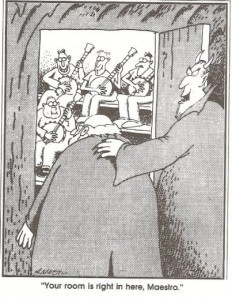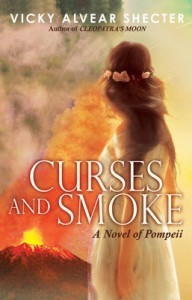Vicky Alvear Shecter's Blog, page 9
September 5, 2014
Friday Funnies–Ancient Style!
September 2, 2014
The Greek God of the Underworld Awaits You!
“Ever notice how people get my name and realm confused? Yeah, it irritates me, too.” -Hades
Hades Speaks! A Guide to the Underworld by the Greek God of the Dead is officially out! The dark lord has a lot to say about his origins, his minions, and all the creepy nooks and crannies of his realm.
“One Greek playwright described my realm as a ‘mass of mire’ and filled with ‘everlasting dung.’ Really?…Where is the respect?” -Hades
Readers will meet the ferryman and slink past Cerberus, the three-headed dog guarding the entrance to Hades’s realms. They’ll learn about Greek death practices and meet his “fiendish staff.”
“See that winged man over there? That is Thanatos, God of Death. Wait, you thought I was the god of death? No, no, I am the god of the dead and of my realm. Thanatos is the one who kills ya.” -Hades
Plus, they get to meet Hades’s wife, Persephone and her witchy attendant, Hekate.
“Welcome little mortal. It has been some time since a living human has dared to visit us here in the palace. Good luck making it out…” -Persephone
Readers will meet fierce giants with fifty heads and one hundred arms guarding the entrance to the pit in Tartaros containing the defeated Titans. And they’ll learn about the other “famous” residents of Tartaros, such as Sisyphus, Tantalus, and Prometheus.
Finally, readers end their “tour” of the underworld in Elysium, where heroes and the “virtuous” went.
“[Elysium] is the place where heroes live ‘immortal lives.’ Except they’re dead. Yeah, just go with it.” -Hades
At the end of the book, Hades tells readers they can leave his realm by either backtracking to face Cerberus or floating through one of the Two Gates of Sleep and possibly face the Oneiroi, batlike bringers of bad dreams.
“Up to you, kid. But make up your mind quickly. I don’t have an eternity to wait for you, you know. (Oh wait, I do…never mind.)” -Hades
Early reviews say this is the perfect book for kids in 4th through 7th grade who love Greek mythology and/or are fans of Rick Riordan’s Percy Jackson series. Want a free, signed copy? Leave a comment! Also share on Facebook and Twitter (let me know you’ve done so in the comments) for extra chances. Giveaway ends September 17.
August 26, 2014
No, Pompeii was NOT Destroyed in August
At least once during August, you’re likely to hear, “On this day/month in history, Vesuvius erupted and destroyed the ancient Roman city of Pompeii.”
Um, not exactly. According to many scholars, Vesuvius erupted much later in the fall.
Still, most Latin and history textbooks continue to print (and reprint) August 24th as the unquestioned date of eruption. Why?
As most things historical, it’s complicated.
We got the August 24 date of eruption from the earliest translation of Pliny the Younger’s letters—an eyewitness account of the disaster. Some believe, however, that the medieval monk who originally translated the text made an error that just kept getting copied over and over again for centuries until it became “fact.”
There is convincing physical evidence that the eruption took place in the fall—some say September or October and possibly even November. This evidence includes the presence of autumnal fruits including pomegranates and crabapples, (both of which ripen in late September and October in Italy) as well as dried dates, prunes, and figs.
The most compelling evidence, however, is the presence of a Roman coin printed after September 7 or 8 of the year 79 CE found in the correct stratification. In other words, looters or investigators could not have dropped it after the event. The eruption must have occurred—at the very least—after the minting and widespread distribution of that coin.
While in Pompeii doing research for my young adult novel set in the doomed city (Curses and Smoke), I interviewed Italian archaeologist Mario Grimaldi about this issue. He agreed that it likely took place sometime after August. “Most archaeologists working on the site believe it took place in the fall,” he said. “The evidence is too strong.”
“So why hasn’t that knowledge trickled down to the rest of us?” I wondered.
In response, professor Grimaldi gave the classically-adorable Italian shrug that meant, “Who knows?” And possibly, “Who cares?” Italian archaeologists are too busy desperately trying to preserve the crumbling city in the face of lack of funds to care much about what American textbooks say about anything.
Also, we Americans like to deal with absolutes. It’s much easier to keep publishing that August 24th date than it is to explain that there is some controversy involved. Things are further complicated by the fact that some archaeologists do believe the eruption took place on August 24 and point to fish-gut evidence found in garum sauce (a popular Roman condiment) as proof since they’ve identified remains of fish usually found in late August. From my point of view, though, we know that it took a couple of months to ferment the sauce so finding evidence of fish usually seen in late August doesn’t disprove a later date.
In the face of quibbling scholars, textbook publishers likely decided to continue printing that August 24 date as the day Vesuvius destroyed Pompeii. And they will continue publishing it as “fact” until there is academic consensus on a new date. Silly publishers. Don’t they know that will never happen?
The day all archaeologists and academics agree on the interpretation of any one fact is the day you will hear in the news, “Today, on this day in history, hell froze over.”
July 30, 2014
Hilarious! Uma Thurman as Hera
I absolutely love this short film of “mundane” Hera. Check it out:
June 18, 2014
Weighing Hearts–Just Like Anubis!
Today I visited the MAGIC TREE HOUSE camp at my favorite indie, Little Shop of Stories, for an activity related to ancient Egypt. Krista read to them from Mummies in the Morning as I set up and then it was my turn. Only I hadn’t expected the children to be so young.
Oh-oh.
Anubis Speaks: A Guide to the Afterworld by the Egyptian God of the Dead is perfect for nine-to-twelve-year-olds. Would my stories frighten seven year olds?
I started with a simple question: “Is a myth ‘real?’”
“Noooooo,” the children cried.
“Right. A myth is a story people believed,” I said, begging forgiveness from the gods of graduate school for the over-simplification. “Not necessarily true or fact.”
I started there because sometimes, at the Carlos Museum, I’m brought up short by a young child–eyes huge with concern–who asks whether the stories I’m telling about ancient religious beliefs are “true.” Since I was going to talk about death, mummies and monsters, I wanted to be clear
about the difference between stories and reality lest I get branded, “The Nightmare Bringer.”
 I shouldn’t have worried. The kids LOVED hearing about Amut the Destroyer and Anubis, the jackal headed god of mummification and death.
I shouldn’t have worried. The kids LOVED hearing about Amut the Destroyer and Anubis, the jackal headed god of mummification and death.
I explained how Anubis weighed the hearts of the dead against the “Feather of Truth” or Ma’at to see if they’d been “good and decent.” Those whose hearts weighed as much as, or less than, the Feather got to live happily in the afterworld for eternity. Those whose hearts did not pass the test where eaten by Amut.
Then I showed them my scale, the feather and the plastic crocodile my daughter borrowed from a friend.
The kids would weigh their own hearts. They got to decide whether they would pass the “Big Test” by either stuffing their felt hearts with nearly weightless fluff, or filling it with beads of bad deeds. They thought that was awesome.
When they were finished, we weighed each little heart against the feather on my trusty scale. Most kids chose to make “light” hearts, but several–giggling all the way–opted to stuff their hearts to the brim with the black and glowing beads of misdeeds (just as I would’ve done as a kid!). When their hearts “failed” the test, our stand-in for the crocodile-headed monster, Amut–the plastic croc–pretended to gobble-up their evil little hearts.
So. Much. Fun!
The kids seemed to enjoy it and I certainly had fun. Camps at Little Shop are always so awesome! Can’t wait to do it again!
June 12, 2014
A Round Up of Ways to Win a Free Copy of CURSES AND SMOKE
There are so many opportunities to win a free copy of CURSES AND SMOKE: A NOVEL OF POMPEII, I thought I’d do a quick round-up. Enter one or enter them all—it’s up to you.
Some are closing within hours or days, so get on it! May the odds be in your favor! 
FREE BOOK FRIDAY: (Ends at midnight tonight, 6/12–hurry!)
http://www.freebookfriday.com/2014/06/curses-smoke-shecter.html
A BOOKISH AFFAIR BLOG:
http://abookishaffair.blogspot.com/2014/06/hf-virtual-book-tours-review-and.html
HISTORICAL TAPESTRY BLOG:
http://historicaltapestry.blogspot.com/2014/06/curses-and-smoke-blog-tour-review-and.html
PASSAGES TO THE PAST BLOG:
http://www.passagestothepast.com/2014/06/win-copy-of-curses-smoke-novel-of.html
LET THEM READ BOOKS BLOG: (Starts Friday 6/13)
http://letthemreadbooks.blogspot.com/2014/06/blog-tour-review-curses-and-smoke-by.html#more
ELIZABETH O. DULEMBA’S BLOG:
http://dulemba.blogspot.com/2014/06/vicky-alvear-shecters-curses-and-smoke.html (Ends Saturday 6/14)
June 6, 2014
They’re Back! Friday Funnies–Ancient Style
In honor of the release of Curses and Smoke: A Novel of Pompeii, I’m going with a volcano/Pompeii theme. Enjoy!
http://unearthedcomics.com/comics-page/
June 3, 2014
A Volcanic Party for the Release of My Pompeii Novel

Volcano cake and lava cupcakes.
I promised everyone a smoking volcano cake at my launch party for Curses and Smoke: A Novel of Pompeii and I didn’t lie. It smoked. I swear! For about ten seconds. Then we discovered that the water we were pouring into the container with the dry ice was dripping inside the cake. Of course, the only proper response to that sort of emergency was to shout, THAT MUST NOT BE ALLOWED TO HAPPEN! Soggy cake?
Gods no.
Still, it was a very cool cake with fabulous cupcakes thanks to Carolyn’s Cupcakes in Decatur. A huge thank you, of course, goes to Little Shop of Stories, my most favorite indie bookstore evah, for hosting the party last Friday night.
It was wonderful to see friends, family and readers come out in support of the book. I signed a book for one teen girl with awesome flowing locks of red, orange and yellow hair. “I wanted to color my hair that way and call it ‘volcano hair,’” I confessed. Her friend with the lilac hair thought I should have.
I gave a brief presentation on Pompeii and on the novel. Some of my fellow docents from the Carlos Museum were there, which made it even more fun because I knew my museum peeps would ask a lot of good questions and they did.
Two things in particular made this night extra special. First, my lovely daughter Aliya made a crown of roses–just like the model wears on the cover–for me. How thoughtful and cool is  that? My handsome son was also at the party but I am not allowed to post pictures or talk about him online because that’s just how he rolls.
that? My handsome son was also at the party but I am not allowed to post pictures or talk about him online because that’s just how he rolls.
Second, I got to see two special friends–Ashley Parsons, who drove in from Alabama, and Kara Levy Beitz, who was moving to Texas the NEXT DAY but still made time to come to my launch party. Such awesome friends and brilliant writers.
Finally, my hubs Bruce made sure everything was all set for the party, especially the volcano cake. When we decided to stop adding water for the smoke (because the yums must not be sacrificed), he made sure to get the cake home in one piece and then stuffed the center with candles which he then set ablaze for me.
So for one brief, shining moment, I had a volcano cake on fire! And then a smoking volcano cake when we blew it out! It was the perfect cap to a perfect night.
And now, Curses and Smoke has officially blown its top and erupted into the world. Thanks everyone for your support–I lava ya for it!
May 30, 2014
Ancient Echoes of the Isla Vista Killer

Wait, this was a “love” spell?
After the tragedy of the misogynist-driven killings in Isla Vista, I felt a little guilty about the lighthearted approach I took in a recent guest post about ancient curses. That’s because, when I reread one of the ancient spells, it suddenly sounded very much like the kind of “curse” the young mass-murdering misogynist might have made.
First, some background. The ancient Greeks and Romans believed that the gods of the underworld and/or unhappy spirits would do their bidding if they appealed to them in specific ways, usually by scratching spells on thin lead tablets and leaving them in certain places, like sacred groves, springs, cemeteries, or temples.
Curses were typically leveled against rival chariot teams, as well as former lovers, legal combatants, thieves, and every conceivable type of individual involved in an inter-personal conflict. The ancients didn’t kid around either—they beseeched the dark gods to have their enemies “hearts and soul” twisted until they “could not breathe”—or their tongues bound, limbs and sinews snapped, and internal organs liquefied from the inside out. For the ancients, when it came to curses, it was go big or go home.
When I first came across the ancient voodoo-like clay figure of a female featured in the previous column, I just assumed—given the violence of it (hands and feet bound, and pierced by thirteen needles) that it was a woman trying to get rid of a female enemy or rival (hmmmm, I should probably try to unpack that assumption too…but that’s a different post).
It was, instead, a violent type of love-curse.After having statuette pierced, the spell-caster wrapped the figurine in a lead curse tablet wherein he beseeched the gods and spirits of the underworld to:
…Not allow her to accept for pleasure the attempt of any man, just that of me…Drag her by the hair and her heart until she no longer stands aloof from me…obedient for all the time of my life, filled with love for me, desiring me, speaking to me the things she has on her mind. (Source: Curse Tablets and Binding Spells from the Ancient World, edited by John Gager, Oxford University Press, page 98.)
“Drag her by the hair?” Um, okay. The choice of words and, especially, the violence perpetrated on the figurine belies its categorization as a “love” spell. This wasn’t love, but a rage fueled lust that came with a demand for total control.
According to one classicist, the majority of spells of this sort were made my men against women (83% have a “male agent and female victim”).
There are other chilling examples of angry “love” bindings. We can only imagine the rage these ancient men must have felt when they discovered the women they “magicked” continued to act with autonomy and not choose them for lovers.
Both the “manifesto” of the Isla Vista killer and the wording from the above “spell” share a sense of violent outrage at not getting their demands met from specific women. However, in the ancient world, women were considered one step above slaves. They had few rights and almost no agency or autonomy. So it shouldn’t be much of a surprise then, that some men perhaps even most men, believed that they had the right to the affections of “lesser” beings who had no rights of free choice.
Yet two-thousand years later we are still dealing with the vestiges of that kind of misogyny.
Only today, we have guns.
May 20, 2014
Well, Hello There! Meet My Main Character
Author Judy Ridgley tagged me in a “Meet my Main Character” blog-hop chain. So come on along and I’ll tag others who might want to play.

1. What is name of your character? Is he/she fictional or a historic person?
There are two main characters in Curses and Smoke: A Novel of Pompeii, and their voices alternate. However, today I’m just going to focus on Tages or Tag, a medical slave in a gladiatorial school because…well, just look at the pic of how I imagine him. Tag falls in love

with Lucia, the daughter of the man who owns him (and she with him), which, as you can imagine, is a bit of a problem. Both characters are fictional.
2. When and where is the story set?
The story is set in the weeks before the eruption of Mount Vesuvius in Pompeii in 79 CE.
3. What should we know about him?
 Tag’s ancestors came from noble Etruscan stock but his family was thrown into slavery when Rome took Pompeii during the “Social Wars” generations before. He is bitterly resentful of the Roman “occupation” of Pompeii (even at the time of the city’s destruction, the Romans still called Pompeii their “colony”).
Tag’s ancestors came from noble Etruscan stock but his family was thrown into slavery when Rome took Pompeii during the “Social Wars” generations before. He is bitterly resentful of the Roman “occupation” of Pompeii (even at the time of the city’s destruction, the Romans still called Pompeii their “colony”). Although in his heart he is a healer, Tag dreams of training to fight in the arena as a means to win his freedom.
4. What is the main conflict—what messes up his life?
The main conflict is that he falls in love with the daughter of the man who owns him. Any kind of relationship between them would’ve been seen as a major taboo. In addition, his father is beginning to lose his faculties and he is desperate to keep the master from noticing because he is afraid his owner would throw the aged healer out on the street once he lost his usefulness.

5. What is his personal goal?
Tag’s personal goal is to earn his freedom. The quickest way to do that, he thinks, is to train like a gladiator. If he wins enough bouts, he could be freed—or die trying. When he and Lucia get together, his goal changes and he dreams of running away with her, even though he knows he would be crucified for touching her.
6. What is the book’s title and when will it come out?
The title is Curses and Smoke: A Novel of Pompeii. It is published by Arthur A. Levine/Scholastic and releases May 27.
Pre-order Curses and Smoke: A Novel of Pompeii at:
IndieBound
Amazon
B&N
Check out other “Meet My Main Character” Posts in the coming weeks by authors
Elizabeth Dulemba
and
Tracy Barrett












